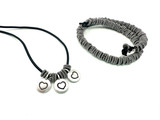Gemstone Index: Peridot
 This olivine variety is composed of magnesium iron silicate. Peridot (pronounced PEAR-ih-doh or PEAR-ih-dot) is created under great temperatures and pressures deep within the Earth, and sometimes is extruded in basaltic lavas. Its yellow-green color is mainly dependent on the amount of ferrous iron present. The traditional birthstone of August, peridot's name origin is uncertain, but several theories exist. Some attribute it to the French peritot, meaning "unclear" (probably due to the inclusions and cloudy nature of large gemstones). It also could be named for the Arabic word faridat, which simply means "gem." Peridot splits and bends the rays of light passing through it, giving it a velvety, sleepy appearance along with a rich glow. Throughout time, peridot has been confused with many other gemstones, including emerald. In fact, many "emeralds" in royal treasures have turned out to be peridots! Other green gemstones confused with peridot are apatite (which is much softer), green garnets and moldavites (which have no double refraction), green tourmaline and green sinhalite (both of which are strongly pleochroic), and green zircon (which is significantly heavier).
This olivine variety is composed of magnesium iron silicate. Peridot (pronounced PEAR-ih-doh or PEAR-ih-dot) is created under great temperatures and pressures deep within the Earth, and sometimes is extruded in basaltic lavas. Its yellow-green color is mainly dependent on the amount of ferrous iron present. The traditional birthstone of August, peridot's name origin is uncertain, but several theories exist. Some attribute it to the French peritot, meaning "unclear" (probably due to the inclusions and cloudy nature of large gemstones). It also could be named for the Arabic word faridat, which simply means "gem." Peridot splits and bends the rays of light passing through it, giving it a velvety, sleepy appearance along with a rich glow. Throughout time, peridot has been confused with many other gemstones, including emerald. In fact, many "emeralds" in royal treasures have turned out to be peridots! Other green gemstones confused with peridot are apatite (which is much softer), green garnets and moldavites (which have no double refraction), green tourmaline and green sinhalite (both of which are strongly pleochroic), and green zircon (which is significantly heavier). Peridot is occasionally treated with colorless oil, wax and natural or synthetic unhardened resins, which are placed into voids to improve appearance. Surface fractures are sometimes filled with a colorless hardened substance. It is safe to assume that any inexpensive peridot is treated in one of these ways, ours included. These gemstone beads usually are cut in India, so irregularities in shape, size or other qualities should be expected. The relative softness of peridot requires special care and handling: it is susceptible to acids, particularly hydrochloric and sulphuric, which will remove a gemstone's polish surprisingly quickly. Quick temperature changes, scratches and sharp blows also should be avoided. Do not clean peridot in a home ultrasonic cleaner.
Peridot mining dates back about 4,000 years, and the gemstone is mentioned in the Bible under the Hebrew name pitdah. Valuable peridots have been excavated in Egypt and faceted stones have been found in the ruins of ancient Greece. In Roman times, it was known as "evening emerald," since peridot appears green even in weak light. Peridot is said to have been the favorite gemstone of Cleopatra. The Greeks and Romans referred to peridot as topazion and topazius, respectively, but this name was later given to topaz to end the confusion between the two gems. The gemstone was introduced to Europe during the Middle Ages by the Crusaders, who used it for ecclesiastical purposes. It remained popular in the Baroque era. Hawaiian legend holds that peridot is the goddess Pele's tears, and the Ottoman sultans gathered a large collection during their 600-year reign (1300-1918), with an impressive array of both loose gemstones as well as peridot earrings, rings and other jewelry.
Dreaming of peridot is said to be a warning to use caution. The stone is purported to help slow the aging process, both physically and mentally, and also to facilitate the birthing process. It often is said to help speech, increasing its eloquence and removing impediments, and it sometimes used to find lost or misplaced things. Many believe it to increase patience, confidence and assertiveness. Natural healers use peridot to heal the heart and lungs, but some say the gemstone should not be worn during chakra work, as it places a seal around the chakras.
For years, the United States was the largest producer of peridot, mining it in Arizona, Colorado, Hawaii and New Mexico. However, China and Pakistan are now also competitors for the title of world's largest peridot producer. The gem is also found in Australia, Brazil, China, Egypt, Myanmar and Norway, and has been mined from St John's Island in the Red Sea for more than 3,500 years.
Our China-Cut peridot beads (with item numbers ending in -033-01) are typically consistent in their shape and drill holes, and sized uniformly on each strand. They are often stones of lesser quality, but with higher-quality polishing and faceting than gemstone beads cut elsewhere. Peridot beads cut in India (item numbers ending in -033-09) tend to be somewhat irregular in shape, with holes that are sometimes off-center and rough. Their color is good, but there are sometimes flat spots on the beads, and sizes may vary on each strand.
Gemstone Index Table of Contents
Shop all Peridot Beads
Our Bead Blog
-
Simply Springy 2-Hole Bracelet
Apr 28th 2025Designed by: Guest Designer Deb Floros Suggested Supplies 1 #61-840-50-01 Beadalon Cord, WildFire,
-
Exotic Statement Necklace
Apr 28th 2025Designed by: Guest Designer Deb Floros Suggested Supplies 1 #88-400-003-5 58x50mm Pewter Connector,
-
Rubber Tubing Necklace and Memory Wire Bracelet Set
Mar 21st 2025Designed by: Guest Designer Deb Floros Suggested Supplies 1 #61-622-02 2mm Rubber Cord, Bulk, for J




